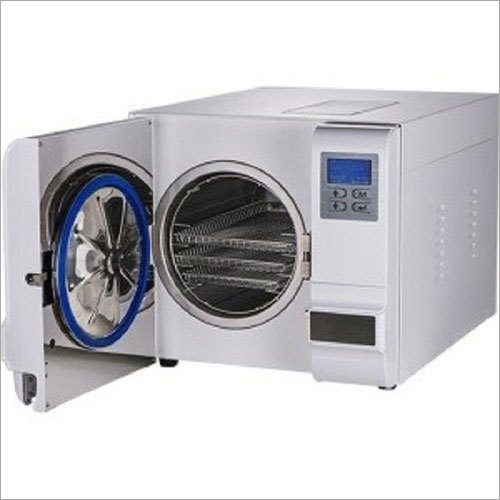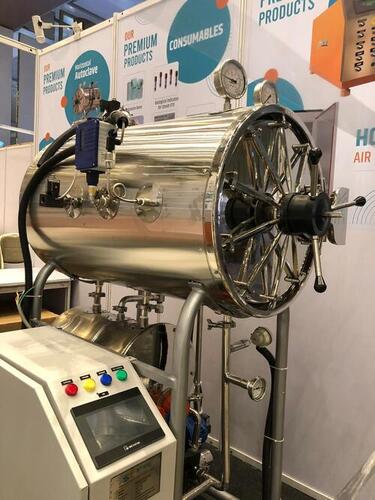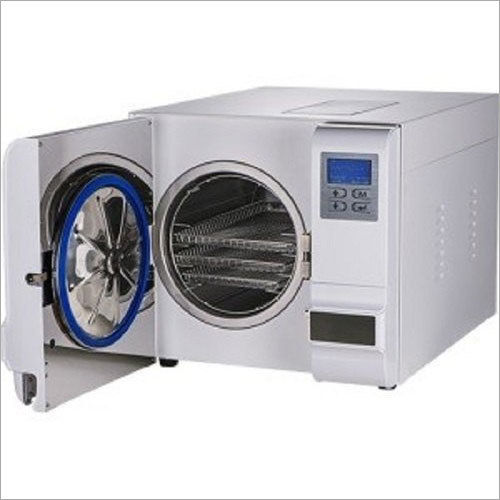Working hours:
Mon-Sat:9.30am to 7.00pm

टेबल टॉप स्टेरलाइजर
200000.00 - 1000000.00 आईएनआर/टुकड़ा
उत्पाद विवरण:
- मटेरियल एसएस 316एल और एसएस 316एल
- चैम्बर का आकार अनुकूलन के साथ उपयोगकर्ता की आवश्यकता के अनुसार
- चैम्बर की मोटाई 4-10 मिलीमीटर (mm)
- अधिक देखने के लिए क्लिक करें
X
मूल्य और मात्रा
- 1
- टुकड़ा/टुकड़े
- टुकड़ा/टुकड़े
उत्पाद की विशेषताएं
- एसएस 316एल और एसएस 316एल
- 4-10 मिलीमीटर (mm)
- अनुकूलन के साथ उपयोगकर्ता की आवश्यकता के अनुसार
टेबल टॉप स्टेरलाइजर व्यापार सूचना
- 5 प्रति महीने
- 30-60 दिन
उत्पाद वर्णन
A tabletop sterilizer is a handy machine designed to disinfect various medical tools, devices, and equipment. It finds frequent use in hospitals, clinics, labs, and other healthcare facilities. What makes this sterilizer particularly convenient is its compact size, allowing it to fit perfectly on a tabletop or countertop. Utilizing advanced sterilizing techniques effectively eliminates bacteria, viruses, fungi, and other harmful germs that could potentially cause diseases and cross-contamination. Typically, the Table Top Sterilizer employs a combination of heat, pressure, and steam to achieve thorough sterilization.
Table Top Sterilizer Features:
1. Sterilization Chamber: The sterilization chamber is the main compartment where the items to be sterilized are placed. It is typically made of stainless steel and has a sealing mechanism to maintain pressure during sterilization.
2. Control Panel: Tabletop sterilizers have a user-friendly control panel located on the front or top of the unit. The control panel allows the operator to set and monitor the sterilization parameters, such as temperature, pressure, and cycle duration. It may include a digital display and touch buttons for easy operation.
3. Sterilization Cycles: Sterilizers offer different pre-programmed sterilization cycles based on the requirements of the items being sterilized. Common cycles include gravity cycles for solid instruments, pre-vacuum cycles for wrapped items, and liquid cycles for fluids. The control panel allows the operator to select the appropriate cycle.
4. Temperature and Pressure Sensors: Tabletop sterilizers are equipped with temperature and pressure sensors to ensure the sterilization process occurs at the desired parameters. These sensors monitor and regulate the temperature and pressure inside the chamber for effective sterilization.
5. Safety Features: To ensure safe operation, tabletop sterilizers incorporate various safety features. These may include automatic pressure release valves to prevent over-pressurization, door interlocks to prevent opening when the chamber is pressurized, and alarms or indicators for temperature and pressure abnormalities.
6. Water Reservoir: Sterilizers require a water source for generating steam. Many tabletop sterilizers come with an integrated water reservoir that can be filled manually or automatically using a water connection. The reservoir is usually equipped with sensors to monitor the water level.
7. Drying Function: Some tabletop sterilizers offer a drying function to remove moisture from sterilized items after the sterilization cycle. This feature helps to prevent the growth of microorganisms and ensures items are ready for immediate use.
8. Data Logging and Documentation: Advanced tabletop sterilizers may include data logging capabilities, allowing the recording and storage of sterilization cycle parameters. This feature enables traceability and documentation for quality control purposes.
9. Connectivity and Integration: Certain models of tabletop sterilizers can be connected to a network or integrated with other devices, such as printers or electronic medical record systems. This connectivity facilitates data transfer, remote monitoring, and seamless integration into existing workflows.
10. Maintenance and Self-Diagnostic Features: To simplify maintenance and troubleshooting, sterilizers may include self-diagnostic systems that alert users to any malfunctions or errors. Additionally, they may have automated cleaning cycles or prompts for regular maintenance tasks.
Frequently Asked Questions:
1. What is the highest temperature that the tabletop sterilizer can attain when sterilizing?
Ans: The tabletop sterilizer's maximum operating temperature normally falls between 121 degree centigrade and 134 degree centigrade when sterilizing.
2. Can both dry and wet sterilizing techniques be utilized with the tabletop sterilizer?
Ans: Yes, the tabletop sterilizer allows for versatility in the sterilization process and may be used for both dry and wet sterilization procedures.
3. How frequently should I service my tabletop sterilizer?
Ans: To ensure your tabletop sterilizer operates at its best and lasts as long as possible, maintenance is advised at regular intervals, often every 3 to 6 months.
Tell us about your requirement

Price: Â
Quantity
Select Unit
- 50
- 100
- 200
- 250
- 500
- 1000+
Additional detail
मोबाइल number
Email






 English
English Spanish
Spanish French
French German
German Italian
Italian Chinese (Simplified)
Chinese (Simplified) Japanese
Japanese Korean
Korean Arabic
Arabic Portuguese
Portuguese